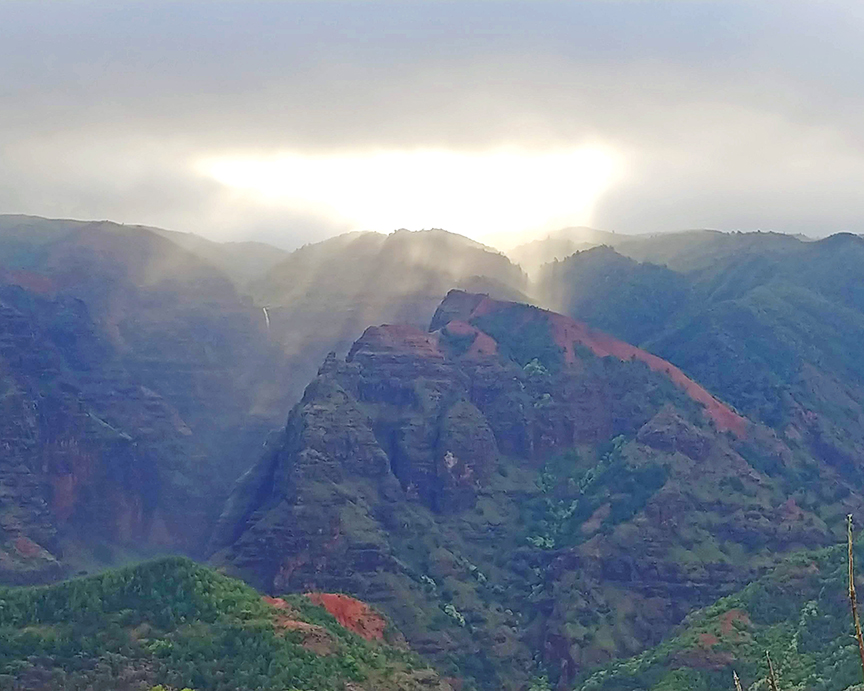By Virginia Beck

A Pueo, or short-eared owl, in Kahana, Maui. Photo by Kim Starr
Is the pueo a messenger of gods or an endangered native Hawaiian owl? Maybe it is both. In the island kingdoms of ancient Britain, one said, “when the iron came to the land,” to refer to a time when the magic left those islands. It refers to the driving out of the “little people”, the “faerie folk”, or perhaps just the short stature people. The early settlers, nature-friendly, lived in balance with the natural world, since their survival depended on it for everything.
Their total respect for the Earth, the land, the miracles of sun, rain, weather, growing seasons and game to hunt or fish was the keystone of survival. Whether the growing seasons to harvest foods, or trees giving food, shelter, tools, medicines and dyes, their cultural knowledge passed through generations. This was matched by many tribal people, including the first people of Hawai‘i.
The Hawaiian’s reverence for owls is woven through history and mythology. From Druids to Athenians, from Asia to Hawai‘i, owls have been messengers of fate, bearers of fortune, guides and protectors.
In Western culture, the owl was the messenger to Athena, goddess of wisdom and war. They keep each other in balance.
When Romans, Vikings and Christianity came to Britain, they brought the new technology; iron.
Spears, and shields and other weapons drove the native people away and underground — either in graves or in the deep forest, boggy fens or highest mountains. The culture went with them.
Pueo, our short-eared owl, a bird unique to Hawai‘i, is slowly being driven away as it loses its natural habitat. It arrived around 300 AD, around the same time as the Hawaiians, or just before. Development gradually devours the lowland ranges of this daytime cruiser, and attractive trash along highways contributes to the extinction of this species by automobile.
In ‘Ōmaʻo and Kalaheo, homes and invasive trees slowly encroach on the open grasslands, territory to generations of Pueo. They sail over meadowlands and cropped fields, searching for rats and other small prey. An abundance of owls once limited these pests.
Hawaiians believe in kinolau, the manifestation of ancestors passed on who returned as birds, rocks, animals or sea life; to guide and guard their descendants. The ʻaumakua could be sharks, octopuses, sacred rocks, birds or owls. Shark sightings led to fishing grounds or warned of storms. Owls were believed to be the messengers between the spirit world and this one.
Hawaiian legends say that the god Kane took the form of an owl to shield and protect his people. Warriors could watch the owl’s flight to seek a path to safety, or a warning of things to come.
Pueo was a protector during war or a warning, providing safety in times of danger.
His great eyes watched over the peace of families, guiding them in times of trouble, comforting them in grief. Relaying messages from the spirit world, he connected the past and the future.
Another story tells of Kamehameha’s army in fierce battle. An embattled warrior driven to the cliff’s edge was ready to jump, but an owl flew up before him, spreading his wings to hold him safe.
While often called spooky, as it cruises the grasslands of cemeteries, pueo is really searching for prey, scanning for pests. On O‘ahu, the pueo thrives on mongoose, but the owls are now an endangered species there, so more mongoose which prey on birds. Kaua‘i is virtually free of mongoose, so there is less prey for the owls, but better survival for small birds.
On Kaua’i, the pueo is still threatened. Trash thrown out of car windows creates attractive litter for pests and young owls, which can fall victims to cars while hunting. Three pueo have died so far this year, including one that was rescued and then struck down again. We don’t want anymore owls as roadkill.

Virginia Beck
Owls are losing territory, groves of invasive trees crowd the grasslands, and homes divide the pasturelands into smaller sections. When you are lucky enough to see a pueo, wish it well, and think carefully before tossing any opala, or trash, out of your car.
While they cruise in the daytime, they are often best seen during or in the hours just before sunset and dawn. Its cousin, the barn owl, cruises the nights. The South Shore and the Westside offer many excellent views of this majestic, mysterious bird. You may see one perched silently on a telephone pole.
If you are quiet enough and the winds are just right, you may find one of these silent winged beauties slipping past, half-hour after sunset. Send a greeting of aloha, and hope it finds food and safety.
Aloha make us great, one and all.
- Virginia Beck, NP and Certified Trager® Practitioner, offers Wellness Consultation, Trager Psychophysical Integration and teaches Malama Birth Training classes. She can be reached at 635-5618.
Discover more from For Kauai Online
Subscribe to get the latest posts to your email.






Leave a Reply